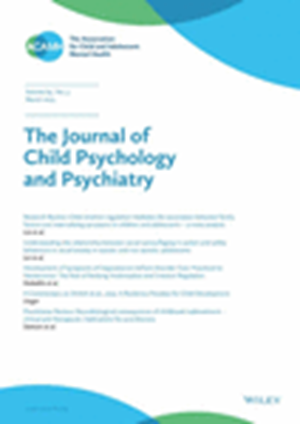注意缺陷/多动障碍儿童在视觉搜索过程中的感觉-运动整合受损。
IF 7
1区 医学
Q1 PSYCHIATRY
引用次数: 0
摘要
目的注意缺陷多动障碍(ADHD)是一种常见的学龄儿童神经发育障碍。异常的感觉-运动整合,如并发的视觉运动选择,是ADHD的一个突出特征。然而,儿童ADHD中感觉-运动整合障碍的潜在病理生理基础尚不清楚。识别ADHD儿童认知障碍的神经标志物对早期辅助诊断和干预目标的选择具有重要意义。方法采集70例ADHD儿童和65例正常发育儿童在执行视觉搜索任务时的脑电图(EEG)信号。采用基于振荡的多元模式解码研究空间注意过程中视觉运动协调。结果与TD儿童相比,ADHD儿童在准确性、反应时间和反应时间变异性方面存在缺陷。多变量机器学习显示,ADHD组在基于alpha(视觉相关)和beta(运动相关)功率的解码准确性上存在缺陷,表明感觉定向和运动准备受损。重要的是,患有多动症的儿童表现出α和β解码之间的延迟,这表明并发视觉运动协调的缺陷。然而,这种视觉运动不同步在TD儿童中不存在。此外,α和β解码之间的视觉运动不同步程度可以预测ADHD儿童的行为障碍和症状严重程度。结论并发视觉运动协调障碍可能是ADHD儿童感觉-运动整合障碍的潜在神经标志物,进一步促进了对认知缺陷的认识,为神经发育障碍的早期诊断和优化干预提供了潜在的研究方向。本文章由计算机程序翻译,如有差异,请以英文原文为准。
Impaired sensory-motor integration in children with attention-deficit/hyperactivity disorder during visual search.
OBJECTIVE
Attention deficit hyperactivity disorder (ADHD) is a common neurodevelopmental disorder in school-age children. Abnormal sensory-motor integration, such as concurrent visuomotor selection, is a prominent feature of ADHD. However, underlying pathophysiological substrates of impaired sensory-motor integration in childhood ADHD remain unclear. Identifying neural markers of cognitive impairment in children with ADHD is vital for the early assisted diagnosis and the selection of intervention targets.
METHODS
We collected electroencephalography (EEG) signals from 70 children with ADHD and 65 matched typically developing (TD) children while performing a visual search task. Oscillation-based multivariate pattern decoding was used to investigate visuomotor coordination during spatial attention.
RESULTS
Compared with TD children, children with ADHD showed impairments in accuracy, response time, and response time variability. Multivariate machine learning revealed that the ADHD group showed deficits in alpha (visual-related) and beta (motor-related) power-based decoding accuracy, indicating the impaired sensory orienting and motor preparation. Importantly, children with ADHD exhibited a delay between alpha and beta decoding, suggesting a deficit of concurrent visuomotor coordination. However, this visuomotor asynchrony was absent in TD children. Furthermore, the degree of visuomotor asynchrony between alpha and beta decoding was predictive of behavioral impairments and symptom severity in children with ADHD.
CONCLUSIONS
These observations reveal that impaired concurrent visuomotor coordination might be a potential neural marker of impaired sensory-motor integration in children with ADHD, further advancing the understanding of cognitive deficits, and providing potential research directions for the early diagnosis and optimization of intervention in neurodevelopmental disorders.
求助全文
通过发布文献求助,成功后即可免费获取论文全文。
去求助
来源期刊
CiteScore
13.80
自引率
5.30%
发文量
169
审稿时长
1 months
期刊介绍:
The Journal of Child Psychology and Psychiatry (JCPP) is a highly regarded international publication that focuses on the fields of child and adolescent psychology and psychiatry. It is recognized for publishing top-tier, clinically relevant research across various disciplines related to these areas. JCPP has a broad global readership and covers a diverse range of topics, including:
Epidemiology: Studies on the prevalence and distribution of mental health issues in children and adolescents.
Diagnosis: Research on the identification and classification of childhood disorders.
Treatments: Psychotherapeutic and psychopharmacological interventions for child and adolescent mental health.
Behavior and Cognition: Studies on the behavioral and cognitive aspects of childhood disorders.
Neuroscience and Neurobiology: Research on the neural and biological underpinnings of child mental health.
Genetics: Genetic factors contributing to the development of childhood disorders.
JCPP serves as a platform for integrating empirical research, clinical studies, and high-quality reviews from diverse perspectives, theoretical viewpoints, and disciplines. This interdisciplinary approach is a key feature of the journal, as it fosters a comprehensive understanding of child and adolescent mental health.
The Journal of Child Psychology and Psychiatry is published 12 times a year and is affiliated with the Association for Child and Adolescent Mental Health (ACAMH), which supports the journal's mission to advance knowledge and practice in the field of child and adolescent mental health.

 求助内容:
求助内容: 应助结果提醒方式:
应助结果提醒方式:


